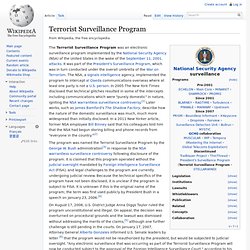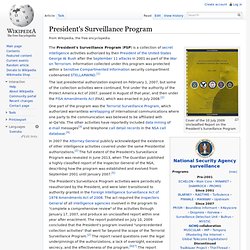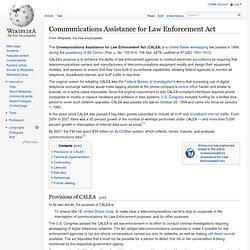

Multistate Anti-Terrorism Information Exchange. The Multistate Anti-Terrorism Information Exchange Program, also known by the acronym MATRIX, was a U.S. federally funded data mining system originally developed for the Florida Department of Law Enforcement described as a tool to identify terrorist subjects.

The system was reported to analyze government and commercial databases to find associations between suspects or to discover locations of or completely new "suspects". The database and technologies used in the system were housed by Seisint, a Florida-based company since acquired by Lexis Nexis. ADVISE.
ADVISE (Analysis, Dissemination, Visualization, Insight, and Semantic Enhancement) is a research and development program within the United States Department of Homeland Security Threat and Vulnerability Testing and Assessment (TVTA) portfolio.

It is reported to be developing a massive data mining system, which would collect and analyze data on everyone in the United States and perform a "threat analysis" of them.[1] The data can be everything from financial records, phone records, emails, blog entries, website searches, and any other electronic information that can be put into a computer system.[2] The information is then analyzed, and used to monitor social threats such as community-forming, terrorism, political organizing, or crime.[3] See also[edit] References[edit] External links[edit] Terrorist Surveillance Program. The program was named the Terrorist Surveillance Program by the George W.

Bush administration[3] in response to the NSA warrantless surveillance controversy following disclosure of the program. It is claimed that this program operated without the judicial oversight mandated by Foreign Intelligence Surveillance Act (FISA), and legal challenges to the program are currently undergoing judicial review. Because the technical specifics of the program have not been disclosed, it is unclear if the program is subject to FISA. It is unknown if this is the original name of the program; the term was first used publicly by President Bush in a speech on January 23, 2006.[4] On August 17, 2006, U.S. Even if the laws of surveillance are not always clear, the NSA still works to protect the country from terrorism. Basaaly Saeed Moalin was charged in 2013 with giving material support to an al-Queda cell based in Somalia named al-Shabaab.
Description[edit] Pen register tap[edit] Call database[edit] President's Surveillance Program. Cover of the 10 July 2009 Unclassified Report on the President’s Surveillance Program The last presidential authorization expired on February 1, 2007, but some of the collection activities were continued, first under the authority of the Protect America Act of 2007, passed in August of that year, and then under the FISA Amendments Act (FAA), which was enacted in July 2008.[2] One part of the program was the Terrorist Surveillance Program, which authorized warrantless wiretapping of international communications where one party to the communication was believed to be affiliated with al-Qa'ida.

The other activities have reportedly included data mining of e-mail messages[3] and telephone call detail records in the NSA call database.[4] Unclassified Report on the Presidents Surveillance Program. Patriot Act. The USA PATRIOT Act is an Act of Congress that was signed into law by President George W.

Bush on October 26, 2001. Its title is a ten-letter backronym (USA PATRIOT) that stands for "Uniting and Strengthening America by Providing Appropriate Tools Required to Intercept and Obstruct Terrorism Act of 2001".[1] On May 26, 2011, President Barack Obama signed the PATRIOT Sunsets Extension Act of 2011, a four-year extension of three key provisions in the USA PATRIOT Act:[2] roving wiretaps, searches of business records (the "library records provision"), and conducting surveillance of "lone wolves"—individuals suspected of terrorist-related activities not linked to terrorist groups.[3] Details[edit] From broad concern felt among Americans from both the September 11 attacks and the 2001 anthrax attacks, Congress rushed to pass legislation to strengthen security controls. Many provisions of the act were to sunset beginning December 31, 2005, approximately 4 years after its passage. Homeland Security Presidential Directive 6. ISP Requirements for Gov Access 18 U.S.C. 2703.
Communications Assistance for Law Enforcement Act. The Communications Assistance for Law Enforcement Act (CALEA) is a United States wiretapping law passed in 1994, during the presidency of Bill Clinton (Pub.

L. No. 103-414, 108 Stat. 4279, codified at 47 USC 1001-1010). CALEA's purpose is to enhance the ability of law enforcement agencies to conduct electronic surveillance by requiring that telecommunications carriers and manufacturers of telecommunications equipment modify and design their equipment, facilities, and services to ensure that they have built-in surveillance capabilities, allowing federal agencies to monitor all telephone, broadband internet, and VoIP traffic in real-time. The original reason for adopting CALEA was the Federal Bureau of Investigation's worry that increasing use of digital telephone exchange switches would make tapping phones at the phone company's central office harder and slower to execute, or in some cases impossible.